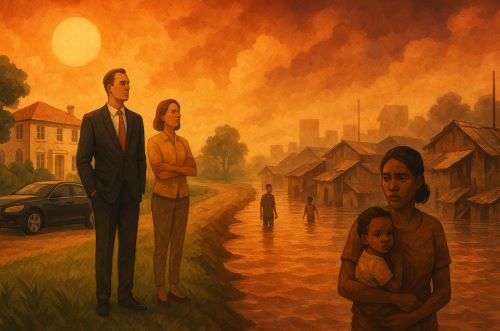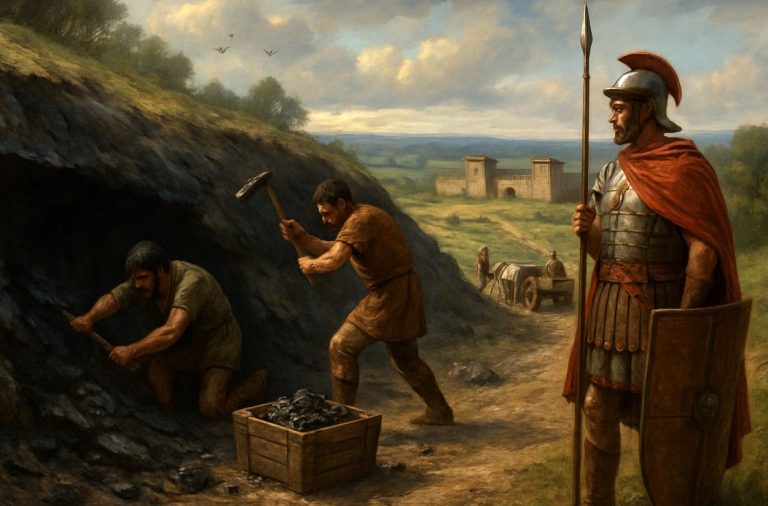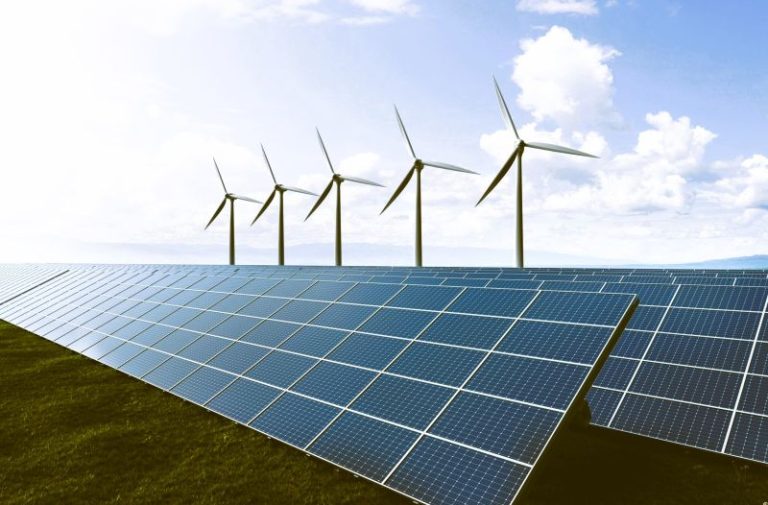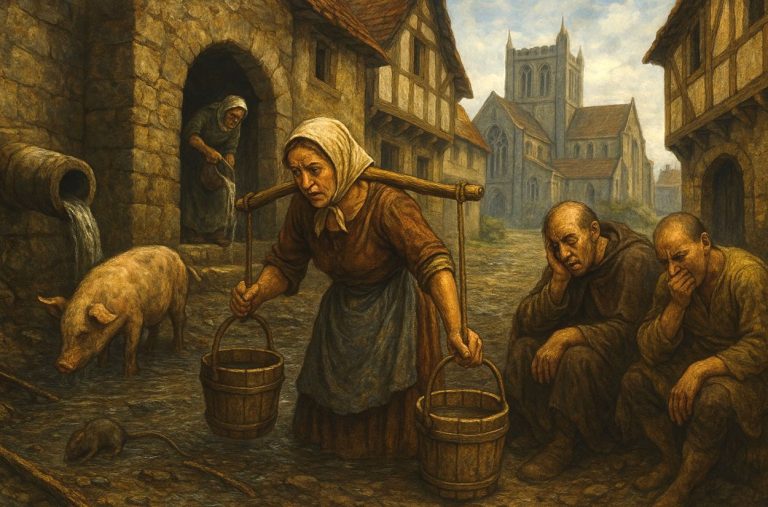

If we want to survive what’s coming, and what’s already here, we must build a world where adaptation is not sold to the highest bidder, but guaranteed as a right.

By Matthew A. McIntosh
Public Historian
Brewminate
A Tale of Two Heatwaves
When a record-breaking heatwave scorched the Pacific Northwest in June 2021, temperatures in Portland reached 116°F, a figure so extreme it melted streetcar cables and buckled roads. But the story wasn’t the same for everyone. In leafy West Hills, where modern homes had central AC, residents hunkered down with chilled drinks and smart thermostats. Just a few miles away, in the city’s historically Black Albina neighborhood, where older homes lack insulation or cooling, people died. Literally.
It’s a pattern we keep seeing: same storm, different outcomes. The climate crisis is not just environmental; it’s deeply economic, racial, and geographic. Adaptation, once viewed as a universal necessity, has become a form of privilege. Those who can afford to prepare — with air conditioning, insurance, evacuations, even relocation — will live. Those who can’t are left to gamble with nature’s increasing fury.
As the world warms, the climate divide is hardening, not just between nations but within them.
Air Conditioning as Survival — and as Status
In much of the Global North, air conditioning is often taken for granted. This is a comfort, perhaps, but not always a necessity. That’s changing. In cities like Houston, Phoenix, or New Delhi, AC is rapidly becoming a medical requirement during summer months. Heatwaves now routinely kill more Americans annually than hurricanes, floods, or tornadoes. The Centers for Disease Control and Prevention (CDC) estimates that over 1,300 people die of heat-related causes in the U.S. each year, and that number is likely undercounted.
Yet access to cooling is far from universal. A 2021 analysis by the American Council for an Energy-Efficient Economy found that Black, Latino, and low-income households are disproportionately energy-burdened, meaning they spend a higher share of income on utilities. For these families, running an AC unit during a heatwave might mean skipping food or medication. Some choose not to run it at all.
Globally, the disparity is even starker. In Sub-Saharan Africa, where extreme heat is becoming more common, fewer than 10% of households have access to any form of mechanical cooling. The United Nations warns that this “cooling gap” could become one of the greatest humanitarian crises of our time, as more regions enter what scientists call “wet bulb” conditions where the human body can no longer cool itself through sweat alone.
Air conditioning saves lives. But in many places, it’s still considered a luxury.
Insuring the Apocalypse
If adaptation begins with keeping cool, it quickly escalates to the ability to recover. That’s where climate insurance comes in, or increasingly, doesn’t.
In states like California and Florida, insurance companies are retreating. In 2023, State Farm and Allstate both announced they would no longer write new homeowner policies in California due to wildfire risk. Farmers Insurance followed suit in Florida, citing escalating hurricane damages. The private market is doing the math, and it no longer adds up.
What happens when insurers flee? Wealthier homeowners might self-insure or pay steep premiums. But for working-class families, it often means going uninsured, underinsured, or being forced out of their homes entirely. Climate change isn’t just destroying property; it’s eroding the very systems that once helped people rebuild.
Globally, the situation is even more acute. According to the Insurance Development Forum, only 4% of natural disaster losses in low-income countries are insured, compared to over 50% in high-income countries. The gap is so vast it’s been dubbed the “protection chasm.” Efforts to close it, through microinsurance schemes or climate risk pools, remain underfunded and largely experimental.
The irony is bitter: the people least responsible for climate change are the least protected from its consequences.
Migration as a Privilege
As sea levels rise and heat becomes unlivable, millions will be forced to move. But like all forms of adaptation, climate migration is easier if you have money.
A family in Miami with means might sell their flood-prone home and relocate inland, perhaps even profit from rising land values elsewhere. A family in rural Bangladesh facing saltwater intrusion? Their options are narrower. Internal displacement, often into urban slums or refugee camps, becomes the default.
Even within countries like the United States, “climate havens” are becoming a hot real estate topic. Cities like Duluth, Minnesota, or Asheville, North Carolina, are being touted as safe zones. But affordability is already shifting. Those with foresight and finances are buying in early. Everyone else will follow later, if they can.
It’s not just geography that shapes survival. It’s mortgage access, property insurance, job mobility, and citizenship status. Climate migration is not just about moving away from danger. It’s about who gets to start over, and who doesn’t.
Infrastructure for the Few
When Hurricane Ida hit New Orleans in 2021, the city’s levees (upgraded after Hurricane Katrina) held. But surrounding parishes, many of them poorer and more rural, weren’t so lucky. Lives were lost, homes were flooded, and entire communities cut off.
This is the new reality of infrastructure under climate pressure. The U.S. has poured billions into retrofitting major urban centers, but less visible regions (tribal lands, small towns, agricultural zones) remain dangerously exposed. And even within cities, investment often follows political clout and wealth concentration.
Green infrastructure (cool roofs, stormwater basins, urban tree canopies) is booming in parts of San Francisco and Brooklyn. But try finding those features in the South Bronx or the Lower Ninth Ward. Despite glossy climate plans, the actual rollout of protective infrastructure continues to reinforce old boundaries.
When the storm comes, it doesn’t discriminate. But the systems designed to withstand it often do.
The Politics of Delay and Denial
For decades, climate policy has centered on mitigation. This includes emissions targets, green energy transitions, carbon markets. Adaptation was the afterthought. That mindset is changing, but slowly and unevenly.
We now live in an era where adaptation and mitigation must be pursued simultaneously, at full speed. Yet political will lags. Even modest adaptation bills, like federal funding for heat-resilient housing or floodproofing low-income neighborhoods, face gridlock. Meanwhile, fossil fuel subsidies persist, and climate denial morphs into climate delay.
Worse, adaptation itself is becoming politicized. In Florida, some lawmakers have banned the use of “climate change” in state communications. In Texas, cities are penalized for enacting local environmental regulations. In such a landscape, planning for a hotter, harsher world becomes an act of resistance — and a necessity.
Conclusion: Survival Shouldn’t Be a Luxury
The moral logic of climate adaptation should be simple: protect the most vulnerable first. Instead, we’ve inverted that ethic. Those with the fewest resources are left with the fewest options. Meanwhile, the rich buy resiliency (insurance, escape, backup generators) like another asset.
This is the new climate divide. It is not a storm on the horizon. It’s already here, reshaping our cities, straining our infrastructure, and testing the bonds of solidarity.
If we want to survive what’s coming, and what’s already here, we must build a world where adaptation is not sold to the highest bidder, but guaranteed as a right. That means rethinking how we invest, legislate, and care for each other. Because in the climate to come, the question will not just be how hot it gets. It will be: who gets to live through it.
Originally published by Brewminate, 07.14.2025, under the terms of a Creative Commons Attribution-NonCommercial-NoDerivatives 4.0 International license.


